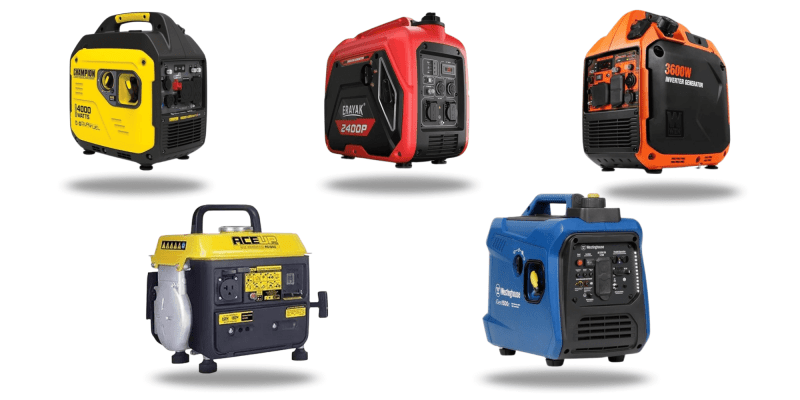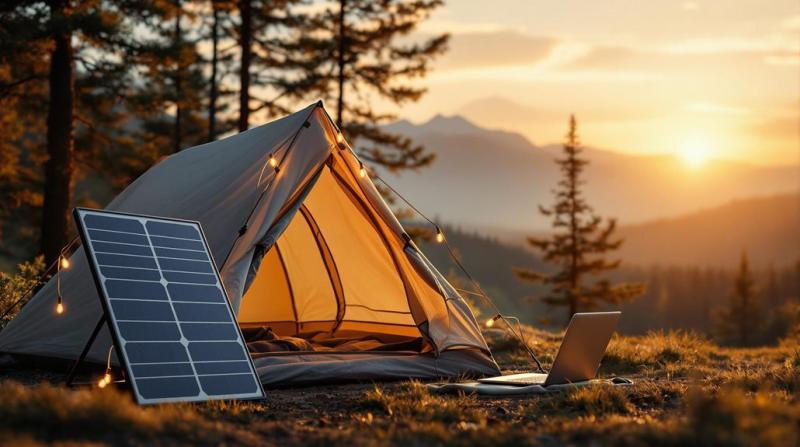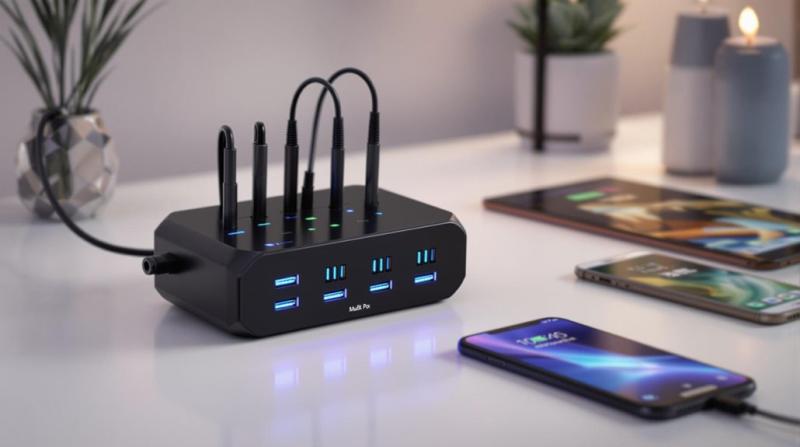When checking out top portable power stations, you'll see that battery capacities really run the gamut, from around 150Wh to over 3000Wh. A higher watt-hour rating translates to longer usage times for your devices, which can be a game-changer depending on what you need.
For short trips, something in the 150Wh to 500Wh range is often more than enough. If you're looking to power laptops or small appliances, you might want to bump it up to the 500Wh to 1000Wh models. Planning a long camping trip or need an emergency backup? Go for units with over 1000Wh.
It's also smart to think about factors like battery technology and what devices you plan to use. Doing so will help you make a wise choice.
Stick around, and we'll dive into more insights to help you pick the perfect portable power station.
Understanding Battery Capacity
When choosing a portable power station, understanding battery capacity is crucial. It directly influences how much energy you can store and use for your devices. Think of battery capacity, usually measured in watt-hours (Wh), as the total amount of energy the power station can hold. The higher the watt-hour rating, the more energy you can store, which means longer usage times for your gadgets.
Think about what you'll be powering. Charging your smartphone? A small capacity might do the trick. But if you're looking to power larger stuff like a mini-fridge or a laptop, you'll need something with a considerably higher capacity. It's essential to match the power station's capacity with your energy needs to avoid running out of juice when you need it most.
Keep in mind, battery capacity isn't the only thing that matters. Efficiency plays a role too. Some power stations might have high capacities but waste energy during conversion or when powering your devices. So, definitely look for models with high efficiency ratings as well.
Also, think about how you plan to use the station. Heading out for a weekend camping trip? A smaller, lightweight option might be perfect. But for longer excursions or emergency preparedness, investing in a larger capacity unit will ensure you have ample power for all your devices.
Ultimately, understanding battery capacity helps you choose the right portable power station for your specific needs, guaranteeing reliable energy wherever you go.
Factors Influencing Capacity
Battery capacity is influenced by several factors that can impact your choice of a portable power station and its performance.
First off, let's talk about the type of battery technology. You've probably heard of lithium-ion batteries—they're super popular because they have high energy density and efficiency. This means you can store more power in a compact size. Pretty cool, right? On the flip side, lead-acid batteries are usually heavier and offer lower capacity. So, if you need something portable, they might not be the best pick.
Now, let's move on to the design of the power station itself. Some models are really well-engineered to maximize efficiency. They have features like built-in smart technology that optimizes power usage and extends battery life. These little design tweaks can make a huge difference in how much usable capacity you actually get. It's all in the details!
Temperature is another biggie. Extreme heat or cold can mess with battery performance. If you're planning to use your power station in varied environmental conditions, look for one that's rated for temperature extremes. You don't want your battery to conk out just because it got a little too hot or cold.
And let's not forget about how you plan to use it. If you're thinking of powering high-wattage devices, you'll need a unit with a higher capacity to handle the load. Always check the power station's specs against your specific needs so you're not left in the dark—literally.
Understanding these factors will really help you pick the most suitable portable power station for your lifestyle and requirements. So, take your time and choose wisely!
Best Battery Capacities Overview
Choosing the right battery capacity for your portable power station can really make a difference in your outdoor adventures or emergency preparedness. Understanding battery capacities is super important because it tells you how long you can keep your devices running. Portable power stations generally range from 150Wh to over 3000Wh, so finding the right fit for your needs is key.
So, if you're just planning short trips or using small gadgets like smartphones and cameras, a capacity between 150Wh to 500Wh should do the trick. This range lets you charge your smaller electronics multiple times without becoming a hassle to carry around.
But, if you're thinking about powering bigger devices, like laptops or small appliances, you should look at capacities between 500Wh to 1000Wh. This range gives you more flexibility and ensures you have enough power for a longer time.
Now, for those of you who love long camping trips or need backup power for home appliances during outages, going for a battery capacity of 1000Wh and above is a smart move. These powerful units can run refrigerators, power tools, and other essential gear, giving you peace of mind in emergencies.
Comparing Popular Models
There are several popular portable power station models on the market, each offering unique features and performance levels that cater to different needs and preferences. When comparing these models, consider factors like capacity, output options, weight, and price.
So, let's talk about the Jackery Explorer series. It's really well-known for its balance of portability and power. You know, it's lightweight and comes with various capacities, making it perfect for camping trips or as an emergency backup.
Now, if you're thinking about something with higher output capabilities, you might want to look at the EcoFlow Delta series. This one can power larger devices like refrigerators and power tools, which is great if you're planning on some heavy-duty use.
Then there's the Goal Zero Yeti series. What makes this one stand out is its modular design. You can easily expand its capacity with extra batteries, which makes it super adaptable for different situations. But, keep in mind, this kind of flexibility usually comes at a higher price point. So, you'll need to weigh your budget against your power needs.
And if you're on a tighter budget, check out the Rockpals 300W model. It offers decent capacity and essential output options without breaking the bank. Sure, it might lack some of the advanced features you'll find in pricier models, but it gets the job done.
Ultimately, the best portable power station for you depends on how you plan to use it. By carefully evaluating your requirements and comparing these popular models, you can make an informed decision that suits your lifestyle and energy needs.
Real-World Usage Scenarios
Portable power stations fit seamlessly into so many real-world scenarios, from outdoor adventures to emergency preparedness. They're seriously invaluable if you're looking for reliable energy on the go. Imagine you're out camping. With a portable power station, you can charge your devices, run small appliances, and even power your portable fridge. So, you get to enjoy the great outdoors without sacrificing comfort or convenience. Pretty sweet, right?
Now, think about urban settings. During power outages, these power stations are a lifesaver. If you rely on medical devices, having a portable power station means you can still access your necessary equipment. Plus, you can keep your phones charged to stay connected with loved ones or emergency services until the power comes back. That's peace of mind right there.
For road trips or tailgating, these stations are a game-changer. You can cook meals, play music, and even charge cameras to capture all those awesome memories. The flexibility they offer is amazing, letting you extend your adventures without worrying about running out of juice.
And if you're working remotely, a portable power station is like your new best friend. Whether you're at a park or a beach, you can power your laptop and stay productive without hunting for an outlet. It's like having a little office wherever you go.
Maintenance Tips for Longevity
To make sure your portable power station lasts as long as possible, regular maintenance is super important for getting the most out of its lifespan and efficiency.
Start by keeping the unit clean and free from dust or debris. Just use a soft, dry cloth to wipe down the exterior, especially around the vents. This little step helps prevent overheating and keeps it running smoothly.
Now, let's talk about battery health. Don't let the battery drain completely before recharging. Aim to recharge it when it drops to about 20%. Keeping it topped up, even when you're not using it, helps maintain its capacity.
And hey, store it in a cool, dry place because extreme temperatures can really mess with battery life.
You've got to use the right charger and cables that came with your power station. Using the wrong ones can damage the battery or make it less efficient.
Also, keep an eye on the cables and connectors. If you see any wear or fraying, replace them right away to avoid bigger problems down the road.
One last thing, check your user manual for any specific maintenance tips for your model. Following these guidelines won't only make your power station perform better but also extend its life.
This way, you get the most out of your investment. Regularly paying attention to these details means your portable power station is always ready when you need it, whether it's for camping trips, emergency backup, or just everyday use.



